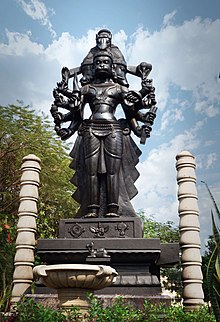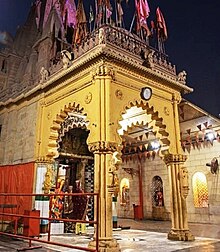Panchamukha
This article needs additional citations for verification. (January 2021) |

Panchamukha (Devanagari: पञ्चमुख) (alternatively Panchamukhi) is a Sanskrit word meaning 'five-faced'. Most of the Hindu deities are shown as having several faces.
Origins of the Panchamukhi Hanuman[]
The origin of Sri Panchamukhi Hanuman can be traced to a story in Ramayana. During the war between Lord Rama and Ravana, Ravana took help of Ahiravana, the king of Patala. Lord Hanuman, in order to protect Lord Rama and Lakshmana, formed a fortress with his tail. Ahiravana took the form of Vibhishana, the noble brother of Ravana, and took Lord Rama and Lakshman to Patala loka.[1]
Taking the five-faced form to kill Ahiravana[]
Hanuman entered Patala loka in search of Rama and Lakshmana, He found that the life of Ahiravana was hidden in the five lamps which were placed in different directions. He could be killed only by extinguishing all five lamps at the same time. To accomplish this, Hanuman had to take the form of Panchamukha Hanuman. This form of Hanuman has five faces. Hayagriva, Narasimha, Garuda and Varaha are the four other faces along with Hanuman's face. Hanuman, using the five faces in different directions, blew out the lamps thereby killing Ahiravana.[2]
[]
According to Hanumath Prakaranam in Sri Vidyarnavatantram, Anjaneya has five faces (Pancha Mukha) and ten weapons. Hanuman is a great yogi (mystic) having transcended the five senses (Pancha Indriyas). In Kamba Ramayanam (in Tamil), the significance of the number five is narrated as follows: the son of one of the five elements (son of wind—Pavana Thanaya) crossed one of the five elements (water—the ocean), through one of the five elements (sky), met the daughter of one of the five elements (daughter of earth—Sita Devi) burnt down Lanka through one of the five elements (fire). Sundara Kanda highlights the heroic exploits of Lord Hanuman at Lanka.[3]
By many, it is considered auspicious to circle the Hanuman idol five times, 14 times, 23 times, 32 times or any amount in which the digits of which add to five. The Panchamukha Hanuman is a rare idol of Hanuman. There are many legends and interpretations. One legend is that Lord Hanuman appeared before Raghavendra Swami in a unique way, amalgamating within him the avatars of varaha, garuda, anjaneya, narasimha and hayagreeva, thus five-headed.[4]
Panchamukha in Mantralaya[]
Panchamukhi, located on the south bank of river Tungabhadra near Manchala, now known as Mantralayam, is where Raghavendra Swami performed penance for 12 years in a cave. In appreciation of his Yoga, Lord Panchamukhi Pranadevaru, Mahalaksmi of Kolhapure, Lord Venkateshwara of Tirupati and Kurmavathara gave him darshan. Then Raghavendra Swami left for Mantralaya where he entered into Samadhi. A temple, the Panchamukhi Anjaneyaswamy temple, was constructed on the spot where Raghavendra Swami performed penance.[5]
Details of Panchamukha[]

East facing Anjaneya to grant Ishta Siddhi[definition needed] to humanity.
South facing Karala Ugraveera Narasimha to grant Abhista Siddhi[definition needed] to humanity.
West facing Mahaveera Garuda to grant Sakala Sowbhagya[definition needed] to humanity.
North facing Lakshmi Varaha to grant Dhana Prapthi[definition needed] to humanity.
Urdhva Mukha being Hayagriva to grant Sarva Vidya Jaya Prapthi[definition needed] to humanity.[7]
Interpretations of Panchamukha[]
Panchamukha can be interpreted as the five ways of praying to God in Hindu philosophy. These five ways are known as naman, smaran, keerthanam, yacham and arpanam. The five faces of Panchamuka are each a depiction of one of these five forms of worship. Hanuman always used to naman, smaran and keerthanam of Rama. He totally surrendered (arpanam) to Rama. He also begged (yachanam) Rama to bless him with undivided love.[8]
From the Bhagavat Gita:
In the Bhagavat Gita, Lord Krishna tells Arjun, "He who acts for me, who is engrossed in me, who is my devotee, who is free from attachment, he reaches me". These five qualities are enshrined in Hanuman; each of his faces represent these five divine qualifications. Maybe an artist thought this over before making the Vigraham. There is a belief that one of the faces is that of Sri Vinayaka.
Half Ganesha and half Hanuman[]
The idol of Adyanta Maha Prabhu depicts a figure of half Anjaneya and half Vinayaka. At Madya Kailas temple Adyar Madras, the idol is an amalgam of Sri Vigneshwara and Sri Anjaneya in the style of Ardhanareeswara (Siva and Parvati) and Sri Sankaranarayana (a combination of Siva and Narayana). The word Aadiyantha means 'beginning to end' (aadi 'beginning', and antha 'end'). There is a Tamil saying, "Begin with Ganesa and end up with Anjaneya". Many people visit the temple to receive a blessing of the Twins against the influence of Navagrahas. The importance of the idol is that Sri Vigneswara and Sri Anjaneya are the only two deities who are totally free from any influence over them whatsoever by the Navagrahas. It is believed that the devotees can and do influence the Navagrahas themselves proportionate to the devoutness with which the devotees address themselves to Sri Aadiyanta Prabhu.
Famous stotras[definition needed] to Panchamukhi Anjaneya[]
Panchmukhi Hanuman Dhyana Mantra
“Panchasyachutamaneka vichitra veeryam |
Sri shanka chakra ramaniya bhujagra desam ||
Peethambaram makara kundala noopurangam |
Dhyayethitam kapivaram hruthi bhvayami” ||
Panchmukhi temples[]
Panchmukhi of Basatiyawala[]
Panchmukhi Hanuman temple of Basatiyawala exists in Yamunanagar district of Haryana near Kalesar National Park.
As part of INR1200 crore Morni-Kalesar tourism development plan announced in January 2019, the government of Haryana is developing this temple, along with Kalesar Mahadev temple, Kapal Mochan Tirth, Sharda Mata Temple of Chotta Trilokpur, Lohgarh fort capital of Banda Singh Bahadur.[9]
Shri Panchmukhi Hanuman Temple, Karachi[]
Shri Panchmukhi Hanuman Mandir is located in Karachi in the Sindh Province of Pakistan.[10] It is a 1,500 year old temple. It is the only temple in the world that has the natural statue of Lord Hanuman.[11]
See also[]
References[]
Citations[]
- ^ http://www.jaihanuman.net/English-3-Stories-2-Panchamuka%20Hanuman.html
- ^ http://www.jaihanuman.net/English-3-Stories-2-Panchamuka%20Hanuman.html
- ^ http://www.jaihanuman.net/English-3-Stories-2-Panchamuka%20Hanuman.html
- ^ http://www.jaihanuman.net/English-3-Stories-2-Panchamuka%20Hanuman.html
- ^ http://www.jaihanuman.net/English-3-Stories-2-Panchamuka%20Hanuman.html
- ^ http://www.jaihanuman.net/English-3-Stories-2-Panchamuka%20Hanuman.html
- ^ http://www.jaihanuman.net/English-3-Stories-2-Panchamuka%20Hanuman.html
- ^ http://www.jaihanuman.net/English-3-Stories-2-Panchamuka%20Hanuman.html
- ^ Kalesar-Kalka stretch to be promoted for tourism, The Tribune, 18 jan 2019.
- ^ "Diwali celebrations begin in Karachi Prayer services, ceremonies organised at temples across the city". Dawn. 27 December 2019. Retrieved 8 December 2020.
- ^ Rabia Ali (19 February 2012). "Recycling history: And all of Hanuman's men put this temple together again". Express Tribune. Retrieved 8 December 2020.
External links[]
- Hindu deities
